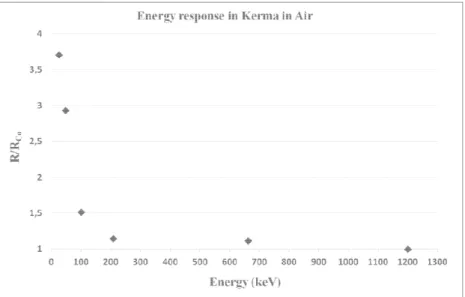HAL Id: cea-02620216
https://hal-cea.archives-ouvertes.fr/cea-02620216
Submitted on 25 May 2020
HAL is a multi-disciplinary open access
archive for the deposit and dissemination of
sci-entific research documents, whether they are
pub-lished or not. The documents may come from
teaching and research institutions in France or
abroad, or from public or private research centers.
L’archive ouverte pluridisciplinaire HAL, est
destinée au dépôt et à la diffusion de documents
scientifiques de niveau recherche, publiés ou non,
émanant des établissements d’enseignement et de
recherche français ou étrangers, des laboratoires
publics ou privés.
Development and experimental validation of TPS
software to determine the out-of-field dose in
radiotherapy beams
Igor Bessières, Bénédicte Poumarède, Jean-Marc Bordy
To cite this version:
Igor Bessières, Bénédicte Poumarède, Jean-Marc Bordy. Development and experimental validation of
TPS software to determine the out-of-field dose in radiotherapy beams. Third European Workshop
on Monte Carlo Treatment Planning (EWG-MCTP 2012), May 2012, Sevilla, Spain. �cea-02620216�
Development and experimental validation of TPS software to determine the
out-1
of-field dose in radiotherapy beams
2
Igor Bessières, Bénédicte Poumarède, Jean-Marc Bordy
3
CEA, LIST, Laboratoire Modélisation, Simulation et Systèmes, 91191 Gif-sur-Yvette CEDEX, France
4
igor.bessieres@cea.fr
5
I. INTRODUCTION
6
Even if the IMRT modality allows a more accurate definition of the target volume in radiotherapy, low doses are
7
still delivered around the tumour to organs at risk. Epidemiological studies [1] demonstrated the relationship
8
between peripheral doses and second cancers or heart diseases. Many experimental studies measuring the
9
variation of the peripheral dose with the treatment parameters have been undertaken [2]. Up to now, very few
10
studies have been performed on out-of-field Monte Carlo (MC) simulations. To our knowledge, MCNPX is the
11
only one MC code that has been used to simulate the peripheral dose in radiotherapy [3]. Nowadays, there is thus
12
no specific and accurate tool predicting the peripheral dose. Our aim is to develop a MC tool based on the
13
PENELOPE code to compute the dose at the target volume and the organs at risk in order to enable a decrease of
14
the peripheral dose by adapting the treatment's parameters. This tool will be implemented in a Treatment
15
Planning System (TPS). In this paper we expose the first validation step of the out-of-field MC calculations,
16
using a comparison with measurements in a specific large water tank.
17
II. MATERIALS AND METHODS
18
a. Experimental validation
19
i. Irradiation configuration
20
The irradiations have been performed at LNHB (French Primary Standard Laboratory) on a GE Saturne 43 linear
21
accelerator for 6, 12 and 20 MV beam qualities. We followed the configuration of the IAEA 398 protocol which
22
implies the use of a 10 × 10 cm² field, a skin surface distance (SSD) of 90 cm and a measurement at 10 cm depth
23
in water. The only difference with the irradiation conditions proposed in this protocol is the use of a large water
24
phantom (60 x 30 x 30 cm3) specially designed for this experiment. We considered a symmetric situation so only
25
one side of the field has been explored.
26
ii. OSL dosimeter
27
Another aim of this experiment is to validate the use of Al2O3:C detectors (Nanodots, Landauer) and the
28
optically stimulated luminescence (OSL) technique for out-of-field dose measurements. The OSL technique
29
presents advantages over the thermoluminescent technique (TL): no sample heating is required and the detector
30
can be read several times. Moreover, OSL measurements are relatively cheaper than TL measurements [5].
31
In this work, OSL dosimeters will be useful for the clinical validation of the code on an anthropomorphic
32
phantom. Measurements performed with Nanodots have been compared to NE2571 ionization chambers (IC)
33
measurements, considered as the reference data here.
34
36
Fig. 1: Energy response of the OSL in Air Kerma
37
divided by the
38
39
Four main factors are applied to the raw reading of the reader
40
measured calibration factor, air calibration factor
41
in air whereas the measurements have been performed
42
factor.
43
Indeed, we measured a high over-estimation of the dose (by a factor 3 or 4) for photon belonging to a low energy
44
range (< 100 keV) [Fig. 1]. Consequently, we developed an e
45
the results of the experimental
over-46
The influence of this correction is described in the next part.
47
b. Calculation tool
48
The tool we are developing is based on the 2006 release of
49
save computation time by running the calculations on a cluster of 372 processors. The simulations a
50
specific large Phase Space File (PSF)
51
jaws of the modelled accelerator. An additional comparison has been done
52
code, the unique MC code used for this kind of studies
53
availability of the DXTRAN variance reduction method. It is specially adapted to the calculation far from the
54
primary beam and was tested in order
55
efficiency.56
III. RESULTS57
a. MC comparison58
As results obtained for 6, 12 and 20
59
experimental and calculated out-of
60
normalized to the maximum of dose
61
: Energy response of the OSL in Air Kerma. The ratio R/RCo corresponds to the raw
divided by the raw response coming from the Cobalt
to the raw reading of the reader: particular sensitivity for each
measured calibration factor, air calibration factor Dwater/Kair correcting the fact that the calibration has been done have been performed in water and finally the energy dependence correction
estimation of the dose (by a factor 3 or 4) for photon belonging to a low energy ig. 1]. Consequently, we developed an energy dependence correction protocol.
-response curve with PENELOPE spectra calculations The influence of this correction is described in the next part.
based on the 2006 release of PENELOPE [4]. This code has been parallelized to save computation time by running the calculations on a cluster of 372 processors. The simulations a
se Space File (PSF) recorded in a 60 × 30 cm2 plane located at 90 cm from the source, the modelled accelerator. An additional comparison has been done using the tally F6 of
code, the unique MC code used for this kind of studies until now. A specific feature of
variance reduction method. It is specially adapted to the calculation far from the in order to assess the gain to be expected on the out-of
and 20 MV quality beams are quite similar, we have reported on Fig. 2 t of-field dose profiles obtained for 20 MV. These dose profiles have been normalized to the maximum of dose.
the raw response of the reader
: particular sensitivity for each Nanodot, the correcting the fact that the calibration has been done energy dependence correction
estimation of the dose (by a factor 3 or 4) for photon belonging to a low energy nergy dependence correction protocol. It combines at measurement points.
[4]. This code has been parallelized to save computation time by running the calculations on a cluster of 372 processors. The simulations are run from cm from the source, after the using the tally F6 of the MCNPX MC ature of MCNPX is the variance reduction method. It is specially adapted to the calculation far from the of-field dose calculation
MV quality beams are quite similar, we have reported on Fig. 2 the These dose profiles have been
62
Fig. 2: Experimental and calculated 20
63
As expected, PENELOPE and MCNPX results
64
measurements (error < 3 %).
65
Out of the field, PENELOPE data are in good agreement with the IC measurements
66
up to most distant points (40 cm). The
67
(~15 %) regarding to the level of dose.
68
Unlike the PENELOPE code, the MCNPX
69
the centre of the beam to the further positions. The global mean error is about 30
70
values.
71
Consequently, compared to MCNPX
72
deposition with a high level of accuracy
73
sections libraries were tested in MCNPX without
74
between both codes are still under investigation.
75
b. OSL comparison
76
On Fig. 2, one can observe that uncorrected OSLs always over
77
the global mean error between OSL and IC measurements is around 5
78
1.1 %. This result demonstrates the relevance of
79
and thus to validate the calculations of the
80
anthropomorphic phantom.
81
c. DXTRAN tests
82
PENELOPE simulations conducted in this study
83
processors for the whole water tank dose calculation)
84
of the low number of particles present
85
: Experimental and calculated 20 MV dose profiles
PENELOPE and MCNPX results in the field are in good agreement with OSL and IC
data are in good agreement with the IC measurements from the centre of the beam cm). The statistical uncertainty associated to the most peripheral points is quite low the level of dose. The global mean error is about 3 % between these two
MCNPX calculations over-estimate more and more the dose from 18
the further positions. The global mean error is about 30 % between
MCNPX, PENELOPE seems to be the best suited to simulate
high level of accuracy. To analyse the difference between the two MC codes, d
sections libraries were tested in MCNPX without significant improvement in the results. Discrepancies observed between both codes are still under investigation.
uncorrected OSLs always over-estimate the dose. Before applying the correction, the global mean error between OSL and IC measurements is around 5.6 %, after correction
result demonstrates the relevance of OSL dosimeters to measure low doses in out
date the calculations of the MC calculation tool in a real IMRT configuration with an
conducted in this study are time consuming (more than 5 days of computation processors for the whole water tank dose calculation). The code converges slowly for these calculations
present out-of-field. Preliminary results obtained about the use of DXTRAN in are in good agreement with OSL and IC
from the centre of the beam statistical uncertainty associated to the most peripheral points is quite low
between these two sets of results. the dose from 18 cm from % between MCNPX and the IC
simulate the out-of-field dose To analyse the difference between the two MC codes, different
cross-results. Discrepancies observed
Before applying the correction, r correction, it decreases to measure low doses in out-of-field regions MC calculation tool in a real IMRT configuration with an
n 5 days of computation on 48 for these calculations because the use of DXTRAN in
The comparison of the MC tool based on PENELOPE with measurements gives satisfying agreements for
out-90
of-field doses. The next step is the clinical validation with the OSL dosimeters within an anthropomorphic
91
phantom and with an IMRT step-and-shoot treatment plan.
92
At the same time we are working on the acceleration of the calculations. The implementation of reduction
93
variance techniques such as DXTRAN in the MC tool should be helpful by increasing calculation efficiency out
94
of the beam. This implementation is undergoing and we will soon be able to give our first results of the
95
acceleration of the PENELOPE code.
96
Part of the work has been done within the framework of EURADOS WG9.
97
V. REFERENCES
98
[1] Tubiana M 2009 Prevention of cancer and the dose–effect relationship: The carcinogenic effects of ionizing
99
radiations Cancer Radiothérapie 13 238–258
100
[2] Xu X G, Bednarz B and Paganetti H 2008 A review of dosimetry studies on external-beam radiation
101
treatment with respect to second cancer induction Phys. Med. Biol. 53 R103–R241
102
[3] Kry S F, Titt U, Followill D S, Ponisch F, Vassiliev O N, White R A, Stovall M and Salehpour M 2007b A
103
Monte
104
Carlo model for out-of-field dose calculation from high-energy photon therapy Med. Phys. 34 3489–99
105
[4] Salvat F, Fernández-Varea J M and Sempau J 2006 PENELOPE—A code system for Monte Carlo simulation
106
of electron and photon transport OECD Nuclear Energy Agency Issy-les-Moulineaux France
107
[5] L Botter-Jensen, SWS McKeever, AG Wintle, Optically stimulated luminescence dosimetry, Elsevier,
108
Netherlands, Amsterdam (2003).

